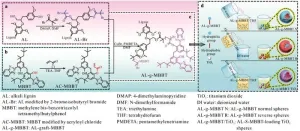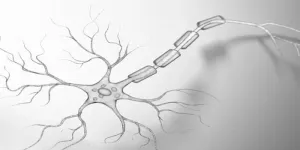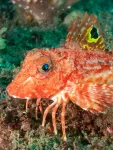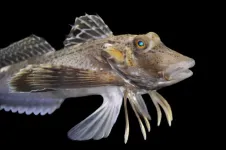Lignin-based sunscreen offers natural and high-performance UV protection
Researchers develop a novel lignin sub-microsphere loaded with TiO2 for enhanced sunscreen capabilities
2024-09-26
(Press-News.org)
In a significant breakthrough for the cosmetics industry, researchers have developed a new type of sunscreen using lignin, a naturally abundant polymer, and titanium dioxide (TiO2). The study, led by Yarong Li and Zhiguang Tang, was published in the Journal of Bioresources and Bioproducts and details the innovative use of a dual-modified lignin sub-microsphere to enhance the SPF and improve the color of sunscreens.
Lignin, a byproduct of the pulp industry, is known for its UV-absorbing properties and antioxidant capabilities. However, its application in commercial sunscreens has been limited due to its low SPF and dark coloration. To address these challenges, the researchers conducted a dual modification of lignin's chemical structure and physical form. They grafted methylene bis-benzotriazolyl tetramethylbutylphenol (MBBT) onto alkali lignin (AL) to create a polymer, AL-g-MBBT. This polymer was then transformed into sub-micron spheres with and without TiO2 loading.
The results were impressive. Sunscreens prepared with 10% AL-g-MBBT3 demonstrated an SPF of 42.93, a significant increase from the 4.74 SPF of unmodified AL. Moreover, the color of the modified lignin-based sunscreen was considerably lighter, with a color difference value (ΔE) of 45.6, compared to the 49.5 ΔE of unmodified AL, making it more appealing for cosmetic use.
The researchers further improved the sunscreen's performance by creating TiO2-loaded sub-micron spheres. These AL-g-MBBT3/TiO2@C sunscreens achieved SPFs of 66.20, outperforming both the unmodified AL and the sub-micron spheres without TiO2 loading. The color of these sunscreens was also significantly improved, with a ΔE value of 36.3.
The study also evaluated the photostability and biocompatibility of the lignin-based sunscreen. The results showed that the sunscreen maintained its sun protection performance and color even after three hours of UV irradiation. Additionally, the biocompatibility tests indicated that the modified lignin-containing sunscreen was non-toxic to human keratinocytes, suggesting it is safe for use on the skin.
This research presents a significant advancement in the application of lignin, offering a sustainable and high-performing alternative to traditional sunscreen ingredients. The findings could pave the way for a new generation of eco-friendly and effective sunscreen products.
See the article:
DOI
https://doi.org/10.1016/j.jobab.2024.09.003
Original Source URL
https://www.sciencedirect.com/science/article/pii/S2369969824000574
Journal
Journal of Bioresources and Bioproducts
END
[Attachments] See images for this press release:

ELSE PRESS RELEASES FROM THIS DATE:
2024-09-26
How did the bodies of animals, including ours, become such fine-tuned movement machines? How vertebrates coordinate the eternal tug-o-war between involuntary reflexes and seamless voluntary movements is a mystery that Francisco Valero-Cuevas’ Lab in USC Alfred E. Mann Department of Biomedical Engineering, set out to understand. The Lab’s newest computational paper published in the Proceedings of the National Academy of Sciences (PNAS) adds to the thought leadership about the processing of sensory information and control of reflexes during voluntary movements—with implications as to how its disruption could ...
2024-09-26
Crohn’s disease — an autoimmune disorder — is characterized by chronic inflammation of the digestive tract, resulting in a slew of debilitating gastrointestinal symptoms that vary from patient to patient. Complications of the disease can destroy the gut lining, requiring repeated surgeries. The poorly understood condition, which currently has no cure and few treatment options, often strikes young people, causing significant ill-health throughout their lifetime. One barrier to making progress in developing treatments has been the lack of preclinical animal models that accurately ...
2024-09-26
HERSHEY, Pa. — The risk of sudden unexpected infant death (SUID) and sudden infant death syndrome (SIDS) increased during the COVID-19 pandemic compared to the pre-pandemic period, especially in 2021, according to a new study led by researchers at the Penn State College of Medicine. Monthly increases in SUID in 2021 coincided with a resurgence of seasonal respiratory viruses, particularly respiratory syncytial virus (RSV), suggesting that the shift in SUID rates may be associated with altered infectious disease transmission.
They ...
2024-09-26
A rescue effort can take many forms – a life raft, a firehose, an airlift. For animals whose populations are in decline from inbreeding, genetics itself can be a lifesaver.
Genomic research led by the University of California, Davis, reveals clues about montane red foxes’ distant past that may prove critical to their future survival. The study, published in the journal Molecular Biology and Evolution, examines the potential for genetic rescue to help restore populations of these mountain-dwelling red foxes. The research is especially relevant for the estimated ...
2024-09-26
A groundbreaking new study conducted by a team of researchers from Arizona State University, University of Washington and the University of Texas at Austin reveals that extreme heat significantly alters how people go about their daily lives, influencing everything from time spent at home to transportation choices. The study, titled "Understanding How Extreme Heat Impacts Human Activity-Mobility and Time Use Patterns," was recently published in Transportation Research Part D and underscores the urgent need for policy action ...
2024-09-26
Digital Science announces ReadCube Pro, an AI-powered expansion of ReadCube, offering researchers new tools to simplify and accelerate literature management and literature monitoring workflows.
The new AI Assistant and Literature Monitoring in ReadCube – an award-winning leader in literature management and full-text document delivery – transform the way research teams access, organize, review and monitor scholarly literature by providing them with enhanced search capabilities while helping to significantly reduce time spent ...
2024-09-26
Leuven, 26 September 2024 – A team of scientists led by Prof. Patrik Verstreken (VIB-KU Leuven) has identified a new genetic mutation that may cause a form of early-onset Parkinsonism. The mutation, located in a gene called SGIP1, was discovered in an Arab family with a history of Parkinson's symptoms that began at a young age. The study reveals that this mutation affects how brain cells communicate, providing new insights into the disease's development and potential treatment strategies.
A genetic clue to Parkinsonism
Parkinsonism is a group of neurological disorders that share similar symptoms, including motor dysfunction ...
2024-09-26
More than a dozen bacterial species among the hundreds that live in people’s mouths have been linked to a collective 50% increased chance of developing head and neck squamous cell carcinoma (HNSCC), a new study shows. Some of these microbes had previously been shown to contribute to periodontal disease, serious gum infections that can eat away at the jawbone and the soft tissues that surround teeth.
Experts have long observed that those with poor oral health are statistically more vulnerable than those with healthier ...
2024-09-26
Sea robins are unusual animals with the body of a fish, wings of a bird, and walking legs of a crab. Now, researchers show that the legs of the sea robin aren’t just used for walking. In fact, they are bona fide sensory organs used to find buried prey while digging. This work appears in two studies published in the Cell Press journal Current Biology on September 26.
“This is a fish that grew legs using the same genes that contribute to the development of our limbs and then repurposed these legs to find ...
2024-09-26
Sea robins are ocean fish particularly suited to their bottom-dwelling lifestyle: Six leg-like appendages make them so adept at scurrying, digging, and finding prey that other fish tend to hang out with them and pilfer their spoils.
A chance encounter in 2019 with these strange, legged fish at Cape Cod’s Marine Biological Laboratory was enough to inspire Corey Allard to want to study them.
“We saw they had some sea robins in a tank, and they showed them to us, because they know we like weird animals,” said Allard, a ...
LAST 30 PRESS RELEASES:
[Press-News.org] Lignin-based sunscreen offers natural and high-performance UV protection
Researchers develop a novel lignin sub-microsphere loaded with TiO2 for enhanced sunscreen capabilities







